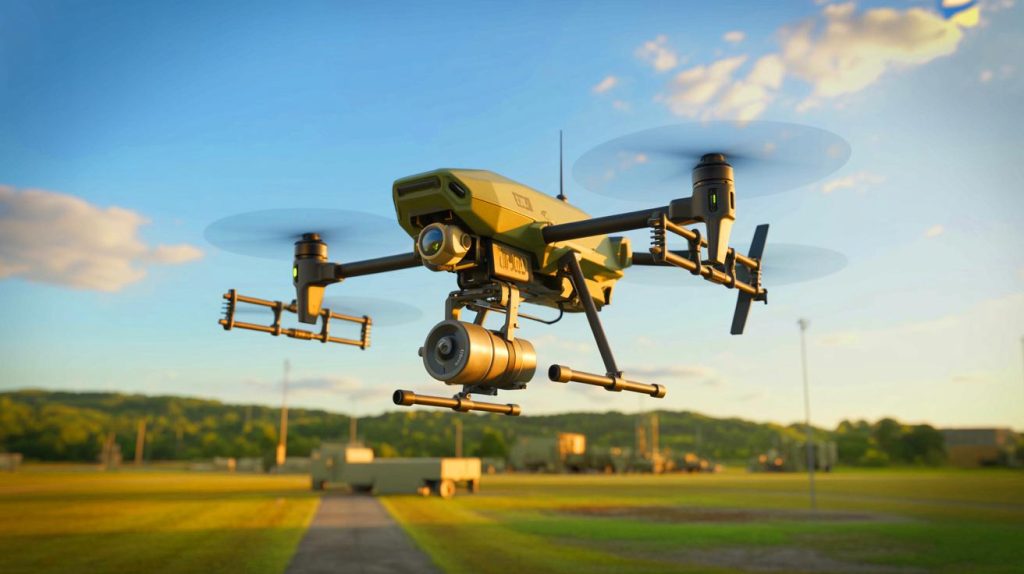| IN A NUTSHELL |
|
In a remarkable military exercise at Fort Rucker, Alabama, the US Army demonstrated a groundbreaking use of drones in combat. A quadcopter equipped with a Claymore landmine successfully destroyed a winged drone in midair. While drones carrying explosives are not entirely new, this instance marks a significant milestone: the first air-to-air kill by an armed first-person view (FPV) drone. This innovation reflects evolving military tactics and the potential for drones to play a more prominent role in future conflicts. The implications of this development are profound, as it signifies a new chapter in modern warfare technology.
The Evolution of Drone Warfare
The use of drones in military operations has undergone significant evolution in recent years. Initially deployed for reconnaissance and intelligence-gathering, drones have now become a vital component in active combat. The US Army’s recent experiment at Fort Rucker is a testament to this shift. By equipping a quadcopter with a Claymore landmine, the military has demonstrated a novel approach to aerial combat.
This tactic is not entirely unprecedented. Both Ukrainian and Russian forces have previously modified drones to carry explosives, using them as steerable cluster bombs against ground targets. However, the US Army’s approach is distinct in its application against aerial threats. The use of a Claymore mine, known for its lethal effectiveness, underscores the adaptability of military technology in response to evolving threats.
The Claymore mine, with its 700 ball bearings and C4 explosive, is traditionally a defensive weapon. Its integration with a drone highlights a strategic shift towards versatility in military applications. This development is part of the broader Project Shank, which seeks to innovate small, cost-effective drones controlled by a single operator. Such advancements may redefine air combat dynamics and offer new tactical advantages on the battlefield.
Project Shank: A New Frontier
Project Shank is at the forefront of the US Army’s efforts to integrate cutting-edge technology into military operations. Spearheaded by the Army Combat Capabilities Development Command Armaments Center (DEVCOM AC), the project aims to create drones that are both efficient and easily deployable. The recent exercise at Fort Rucker is a significant milestone in this initiative.
Controlled by CW2 Nathan Shea, a UAS operations officer with the Pennsylvania National Guard, the quadcopter demonstrated impressive capabilities. During the exercise, the drone successfully tracked and engaged a SkyRaider drone in flight. The detonation of the Claymore mine resulted in the destruction of the target, showcasing the quadcopter’s precision and effectiveness.
This success is not only a technical achievement but also a strategic one. By leveraging lessons learned from conflicts in Ukraine and the Middle East, the US Army is refining its tactics to incorporate drone technology. The potential for drones to perform complex tasks autonomously or with minimal human intervention opens new possibilities for military operations.
Implications for Future Conflicts
The introduction of armed drones capable of air-to-air combat has far-reaching implications for future military engagements. As technology continues to advance, the role of drones in warfare is likely to expand. The ability to deploy drones quickly and effectively can provide a significant advantage in various combat scenarios.
The Fort Rucker exercise is a clear indicator of the US Army’s commitment to staying ahead in the technological arms race. By integrating advanced drone capabilities into its arsenal, the military is enhancing its operational flexibility. This development also raises important questions about the ethical and strategic considerations of using drones in combat.
As nations continue to invest in drone technology, the potential for these devices to reshape military strategy becomes increasingly evident. The lessons learned from recent exercises will inform future tactics and strategies, ensuring that the US and its allies remain prepared for evolving threats.
Lessons from Global Conflicts
The US Army’s drone experiment draws heavily from the experiences of international conflicts. The ongoing war in Ukraine has provided valuable insights into the use of drones as offensive and defensive tools. Both Ukrainian and Russian forces have employed drones in innovative ways, offering a glimpse into the future of warfare.
By studying these conflicts, the US Army aims to enhance its own capabilities. The integration of drone technology into military operations is a response to the changing nature of warfare. As adversaries develop new strategies, the US must adapt to maintain its technological edge.
Project Shank represents a proactive approach to these challenges. By developing drones that can be easily controlled by a single operator, the US Army is positioning itself to respond effectively to a range of threats. This adaptability will be crucial in ensuring success in future engagements, as the battlefield continues to evolve.
The recent exercise at Fort Rucker underscores the potential of drones to transform military operations. As technology advances, the ability to deploy drones in various combat scenarios will be critical. How will the continued evolution of drone warfare influence global military strategies and alliances in the years to come?
This article is based on verified sources and supported by editorial technologies.
Did you like it? 4.6/5 (21)


 The US Army conducted a historic exercise at Fort Rucker, using a quadcopter armed with a Claymore mine.
The US Army conducted a historic exercise at Fort Rucker, using a quadcopter armed with a Claymore mine. This marks the first successful air-to-air kill by an armed FPV drone, showcasing new combat capabilities.
This marks the first successful air-to-air kill by an armed FPV drone, showcasing new combat capabilities. Project Shank aims to develop small, cost-effective drones controlled by a single operator for military use.
Project Shank aims to develop small, cost-effective drones controlled by a single operator for military use. Insights from global conflicts, such as in Ukraine, are informing the integration of drone technology into military strategies.
Insights from global conflicts, such as in Ukraine, are informing the integration of drone technology into military strategies.